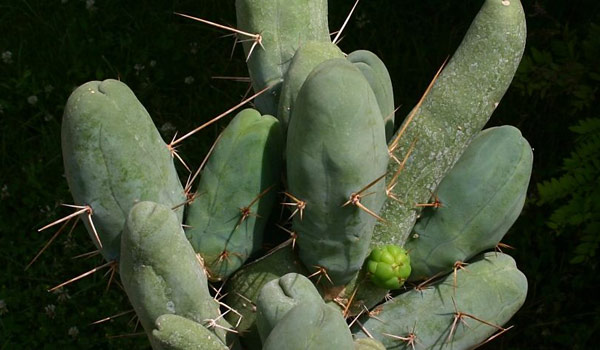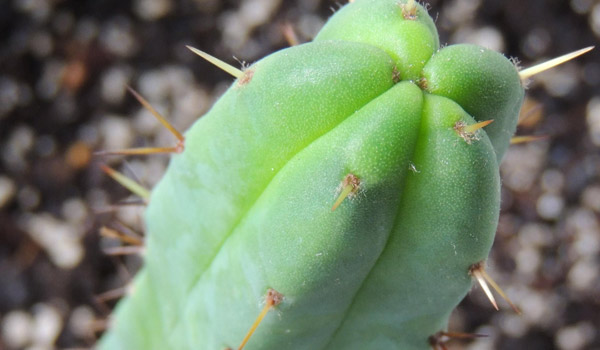Penis Cactus Care Guide (Trichocereus Bridgesii Monstrose)

This peculiar (and very real) cactus is actually a nursery-produced cultivar. The trichocereus bridgesii monstrose, the penis cactus, or simply TBM is a columnar cactus species native to South America, La Paz in Bolivia to be more specific.
This popular cultivar is a mutation that is produced through short-segmented growth. A growth that can only be propagated using vegetative means. This plant gets its common name from its undeniable resemblance to a penis. Despite its curious look, the penis cactus was once highly regarded as a sacramental medicine.
In the following, we will talk about penis cactus care and characteristics, and another well-known cactus often associated with it: Bruce’s dragon cactus.

More about Trichocereus Bridgesii Monstrose
Growing in clusters and branching at the base, it is slow-growing cactus that can reach up to 1’ 4” at full maturity. It has a light glucose green color and stems with short and upright sections. This is the signature of the trichocereus bridgesii monstrose clone A.
The penis cactus does not have too many areolas and spines on its base nodes. The upper part of the stem is smooth with no areolas. The spines grow in groups of four (or fewer than that) with honey to brown color. Be careful about these long spines, as they can grow up to 1 ½ to 2 ½ inches.
Interestingly, we do not know if there is a trichocereus bridgesii monstrose flower. It is unknown that is it a flowering species or not.
There are also other mutant varieties of Trichosurus bridgesii including:
- A cristate variety
- A variegated variety
- Two variants of monstrose growth, clone A and clone B (which is the very penis cactus)
- A clone that has both monstrose and cristate growth
- Another clone that shows both monstrose and variegated growth
Bruce’s Dragon Cactus
Bruce’s dragon cactus is actually a beautiful trichocereus bridgesii variety with broader ribs. And due to these broad ribs, it tends to have relatively few ribs (mostly 4 to 6). Similar to many others, Bruce’s dragon cactus comes from South Australia.
Bruce’s dragon cactus is known for showing a “melting” look from time to time. This look tells us that it is (at least partially) mutated in a way.

Penis Cactus Care
Growing penis cactus is actually quite easy, both indoors and outdoors. Here is what you need to know about penis cactus care:
Water
In trichocereus bridgesii monstrose care, remember that this actually prefers more water than most succulents. In fact, its water needs are really more like ‘normal’ plants than most other cacti. Let the soil dry out between each irrigation and it will do just fine.
Light
If grown outside, Bruce’s dragon cactus and the main verities need full sun. However, during hot summers, these cacti can suffer from sunburns. To avoid this problem, grow your penis cactus in light shade.
And if grown indoors, provide this plant with bright and some direct light. During winter, place it in a cool and bright spot. Stop watering and fertilizing over the winter to encourage winter dormancy as well.
Soil
Any well-drained sandy soil mix is suitable in penis cactus care. Potting mixes with lots of perlite or vermiculite (for proper drainage) and some organic matters (for required nutrients) are great for example. If you went for store-bought cactus soil, add a few handfuls of perlites and your plant will do just fine.
Temperature & Humidity
This cold-hardy plant can handle temperatures as low as -12 °C or less. Another good news is that they are not as sensitive to warm weather as many other cacti.
In penis cactus care, you need to provide a dry environment for your rudely shaped plant! Extra humidity or misting means lingering water on the leaves, which leads to the perfect environment for harmful types of fungi.
Feeding
Most potting soils have the necessary nutrients for the right penis cactus care and produce new growth. However, to boot growth, you can feed your plant. During the trichocereus cactus growing season (or other varieties), apply fertilizer each month using a balanced fertilizer.
Repotting
Cacti are slow growers. But repotting is still an important part of penis cactus care and other succulents.
By the time the trichocereus cactus has depleted the nutrients in the soil, it is likely to double in size and needs a larger pot as well as fresh soil. To replenish the nutrients, repot your cactus when has grown that much or once a year.
Common Problems in Penis Cactus Care
Keep an eye for common problems trichocereus bridgesii monstrose care as well. Avoid overwatering, as they are susceptible to fungal diseases which show themselves as black rotted spots. Damp soil mix in cold periods also leads to the same problem.
Whether you have a trichocereus bridgesii monstrose long form or Bruce’s dragon cactus, you can use these penis cactus care tips to grow a happy and healthy plant. Happy cultivating!
- In this post:
- More about Trichocereus Bridgesii Monstrose
- Bruce’s Dragon Cactus
- Penis Cactus Care
- Common Problems in Penis Cactus Care



